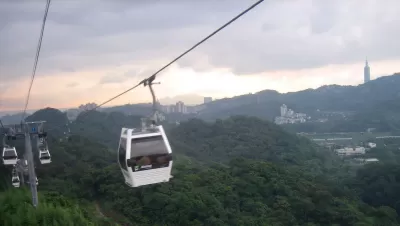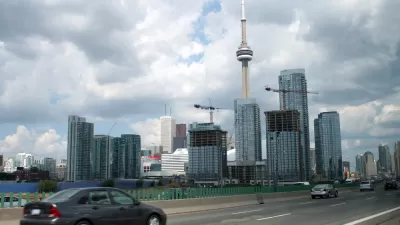One Toronto-area man is hoping that cable cars in the sky will one day complete the metro's transit system, but transportation experts see limited use for the technology.

Keanin Loomis, a resident of Hamilton, Ontario has sky-high visions of a cable car system that will whisk commuters around the area's often difficult topography. He’s so enamored with the idea that he's asked system expert Steven Dale to meet with Hamilton’s Mayor and city staff to discuss the idea. Steve Arnold of The Hamilton Spectator reports that although sky gondolas have taken off in other parts of the world, adoption in North America remains limited.
Traditionally, North Americans have seen cable cars as a fixture of ski resorts or tourist areas. Other parts of the world have been more open minded, seeing them as one component of an urban transit system.
La Paz, Bolivia, has built a network of gondola cars into its transit system — a $235 million chain of 11 stations capable of handling 9,000 passengers an hour. The service has been said to cut commuting time for suburban travellers from two hours to 25 minutes.
Support for such systems has been building in areas where the cost of building around topographical barriers has made more traditional transit options difficult. The footprint of the systems is small and they can be built rather quickly. In addition, they can be built cheaply—a feasibility study for a system in San Diego found that a sky gondola system would cost up to $37.5 million per mile versus $200 million per mile for a light rail system. However, as Arnold notes, integrating sky gondolas into existing metro systems can be difficult and versus other systems (light rail, bus, etc.) can be very slow in moving people from one place to the next.
FULL STORY: Ready for a ride? Dreams of a cable car up the Mountain

Alabama: Trump Terminates Settlements for Black Communities Harmed By Raw Sewage
Trump deemed the landmark civil rights agreement “illegal DEI and environmental justice policy.”

Study: Maui’s Plan to Convert Vacation Rentals to Long-Term Housing Could Cause Nearly $1 Billion Economic Loss
The plan would reduce visitor accommodation by 25% resulting in 1,900 jobs lost.

Why Should We Subsidize Public Transportation?
Many public transit agencies face financial stress due to rising costs, declining fare revenue, and declining subsidies. Transit advocates must provide a strong business case for increasing public transit funding.

Paris Bike Boom Leads to Steep Drop in Air Pollution
The French city’s air quality has improved dramatically in the past 20 years, coinciding with a growth in cycling.

Why Housing Costs More to Build in California Than in Texas
Hard costs like labor and materials combined with ‘soft’ costs such as permitting make building in the San Francisco Bay Area almost three times as costly as in Texas cities.

San Diego County Sees a Rise in Urban Coyotes
San Diego County experiences a rise in urban coyotes, as sightings become prevalent throughout its urban neighbourhoods and surrounding areas.
Urban Design for Planners 1: Software Tools
This six-course series explores essential urban design concepts using open source software and equips planners with the tools they need to participate fully in the urban design process.
Planning for Universal Design
Learn the tools for implementing Universal Design in planning regulations.
Smith Gee Studio
Alamo Area Metropolitan Planning Organization
City of Santa Clarita
Institute for Housing and Urban Development Studies (IHS)
City of Grandview
Harvard GSD Executive Education
Toledo-Lucas County Plan Commissions
Salt Lake City
NYU Wagner Graduate School of Public Service





























